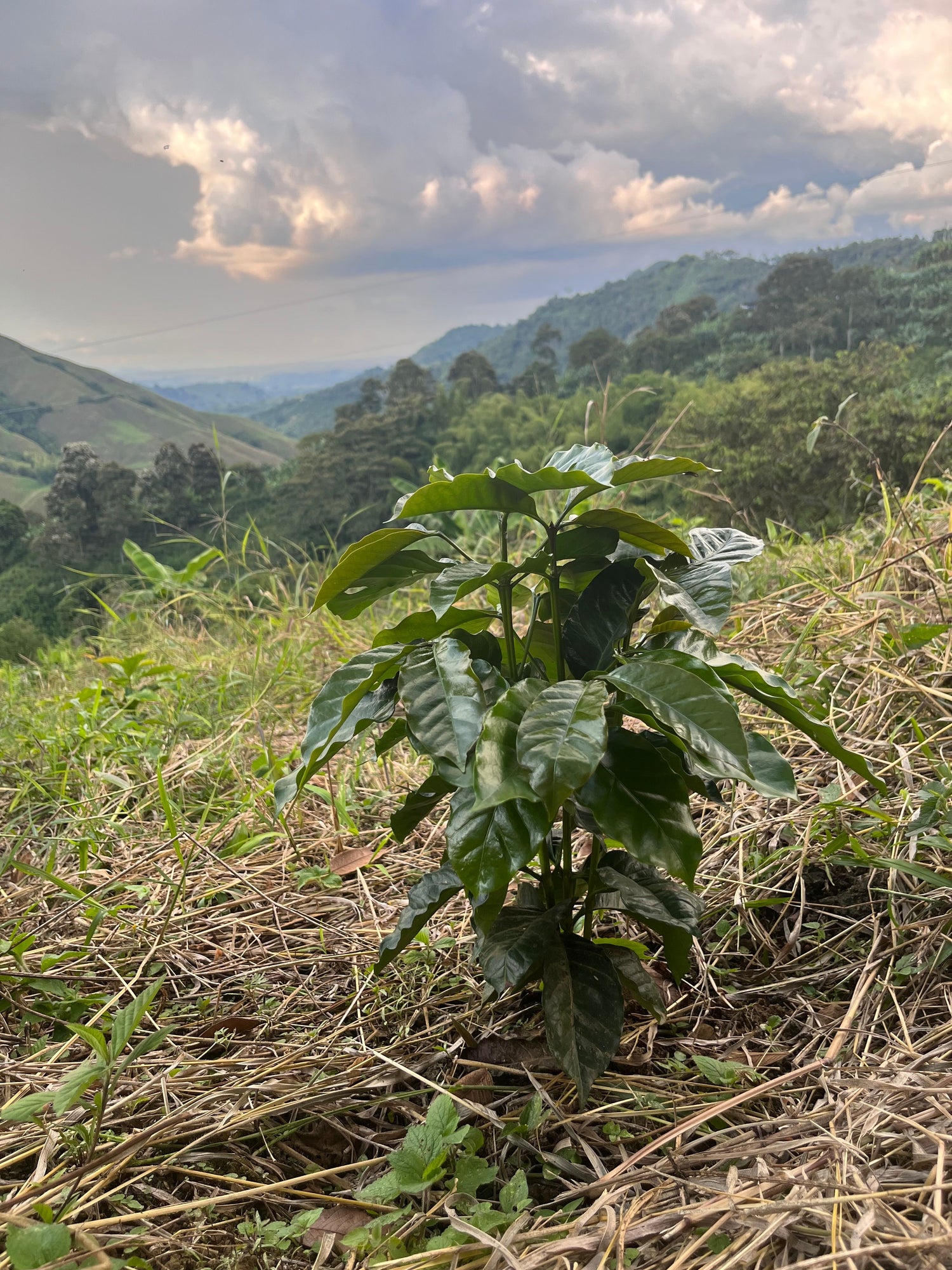We started growing coffee on our coffee plantation in Colombia in 2023. Since we are starting completely from scratch, we know the process from seed to finished coffee plant first hand. As of now (May 2024), the first coffee plants have bloomed for the first time.
In this blog post, we want to explain to you from our experience how the life cycle of the coffee plant works and give an outlook on the future at the end of the life cycle. Have fun!
How is coffee grown?
It all starts with the seeds. In Colombia, these are often hand-picked by the coffee plantation owners and only selected from the best coffee plants. This ensures the best possible quality for the new generation of coffee plants.
How to get the best seeds for the coffee plant?
The best basis is the fruit of the healthiest coffee trees on the coffee plantation. So first of all, coffee cherries must be harvested. After the cherries have been picked, the coffee beans are worked out and the pulp removed. After about 8 weeks, the seeds have the best germination capacity and are planted.
How are the seeds for the coffee plant planted?
Attention! The seeds are not planted directly in the soil. Instead, the seeds are first placed in a small seedbed of loose sand. The sand is enriched with nutrients; rice husks are often used here. The loose sand as soil is important so that the roots can develop straight downwards and do not encounter resistance. The most important criterion for young coffee plants is the root. If the root is sick or crooked, it would result in a sick coffee plant that does not bear many fruits, very small fruits or even no fruits at all. Such young plants must therefore be sorted out individually.
What conditions must be taken into account when growing the coffee plant?
Since the coffee plant is a shade plant, shading is important, especially in this first stage. If there is no natural rainfall, watering is necessary every 2-3 days, depending on the climate and heat.

After a few weeks, the first leaves of the seedlings can be seen. This state is called "chapola" in Colombia. During this phase, the chapolas must be constantly shaded and not exposed to direct sunlight. After about 3 months, the young coffee plants can be transplanted into soil. Traditionally, a kind of pot is made from black foil. This soil is ideally mixed with organic fertilizer to enrich it with more nutrients.

These plants should also be shaded, as they are not yet strong enough to be exposed directly to the equatorial sun. After about 6-8 months, the plants can then be planted directly on the coffee farm.

Ideally together with shade-giving plants, such as banana trees, guamos, Nogales cafeteros, etc. From here on, it takes about 2 years until the coffee plant blooms for the first time.
What should be taken into account when planting the coffee plant on the plantation?
In the early stages of caring for the coffee plant, it is important to strengthen the roots. The stronger the roots become, the better the coffee plant will be able to supply itself with nutrients later on. Therefore, fertilize approximately every 2 months with a phosphorus-containing fertilizer that stimulates root formation.
It is also very important to regularly "clean" the area around the coffee plant. It happens very quickly that grass and other weeds grow over the coffee and suffocate it. In the first year, the field must be carefully cleaned every 2 weeks. On some plantations, this is done using poison. On other farms, with a deeper understanding of the environment, this is done by hand. This is also the case on our farm " Finca La Macarena ", where we follow a sustainable cultivation concept. You are welcome to come and visit us and see how it works. Maybe you'll even be lucky and be able to plant your own coffee tree?
When do coffee plants start producing coffee?

Around 12 months after the coffee plants are planted directly on the coffee plantation, they begin to bloom for the first time. This depends on many environmental factors and can happen a little faster or take a few months longer. The flowers turn into buds, which over time develop into coffee cherries. It takes around 6 months from blossom to coffee cherry, although not all cherries are ripe at the same time. It is not uncommon to see flowers on the branch at the same time as some already ripe coffee cherries. That is why it is important to be careful when harvesting. On many plantations with mass production, it is all about quantity. Here, all the cherries are torn from the branches at the same time using mechanical harvesting methods. The result: a mix of ripe, unripe, overripe and rotten cherries. Mmm, delicious...
If you want to do something good for yourself with your coffee, you should pay attention to how the coffee was harvested. With the "picking method," for example, the coffee farmers go over the coffee plantation every day for months and only pick the ripe cherries. It's an enormous effort, but it's worth it - for you! You can only know how your coffee was harvested if you really know where exactly your coffee comes from. The statement "Colombia" or "Brazil" doesn't give you any information. If the topic of origin is interesting to you, we'll be happy to help you. Take a look at our selection of Colombian coffees and experience what flavors are possible when you drink good coffee from the root! We connect you directly with the country of origin.
How long does a coffee plant “live”?
The average life expectancy is about 12 years.
The plant must be pruned regularly so that it grows more in width than in height, so that harvesting remains possible without tools.
After about 5-6 years, the so-called "poda" is carried out. The trunk is cut off just above the root. This stimulates the plant to grow again. Since the roots are still established, it "only" takes about 1 year until the plant has branches and leaves that produce coffee cherries again.
After a maximum of 6 years, the plant becomes infertile and must be completely replaced. It becomes soil again, fertilizer for the next generation of coffee plants. This is where the circle closes.
If you've read this far, then you seem to be really interested in the topic of coffee plants. We have a reward for you, or more precisely a suggestion: Visit us on our coffee farm in the coffee zone of Colombia! And plant coffee plants yourself, be there during the harvest and learn in practice from real coffee farmers what really matters. We hope to welcome you soon to our finca "La Macarena" .






